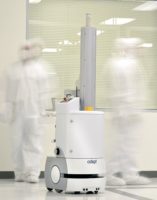Whether it's a compact manual workcell in an electronics plant or a station on an automotive assembly line, workers are increasingly enjoying the benefits of tool lifters to help them do their jobs. In addition to reducing workplace injuries, these devices help improve both quality and throughput. More and more, manufacturing engineers are realizing that every tool should have its place and every place its tool. No matter what the industry, hunting for tools is an obvious waste of time, even if an operator only spends a few seconds doing it.
At the most basic level, assemblers have the option of employing retractors, spring-loaded reels that exert an upward force on a tool, lifting it up and out of the way when not in use. These come in two basic forms: wire reels that are clipped to the tool, which is then powered by a separate umbilical; and line reels, or hose reels, in which the pneumatic umbilical itself supports the tool as it is wound and unwound in the retractor.
In both cases, the retractor can be installed using hooks, shackles or clips. Manufacturers can attach these to an existing overhead structure or to a variety of purpose-built devices, including hinged, single-arm supports, or jib booms, which can be wall-mounted or pedestal-mounted either on the floor or a workbench surface. For those cases in which an operator needs even greater mobility, there is the option of an overhead rail system. These can be especially effective when used on a moving assembly line or in a large workcell.
Similar to retractors are balancers, which can be set to either lift a tool up and out of the way, or to hold a tool at the exact point where it is released, essentially leaving it hanging in midair. The advantage to this approach is that the operator doesn't have to reach up to retrieve a tool. Obviously, if the tool is used in just one of a number of operations at a given workcell or station, the reaching action won't be overly burdensome. However, if an operator is installing multiple fasteners with a single tool, having the tool immediately at hand can make a world of difference.
Then there are articulated or linear torque arms, which both support a tool's weight and help protect operators from harm as they install threaded fasteners. These systems, which can be used with either pneumatic or electric tools, generally hold the tool so that it remains in a vertical orientation, although adapters can be added to set the tool at an angle or even at horizontal. In the case of a linear arm, a single-piece arm both revolves around, and travels up and down on a fixed shaft. In the case of an articulated arm, a jointed arm allows the tool cover the entire area within the arm radius.
Finally, for those really big jobs there are torque tubes and vertical balancers. These devices move up and down with the aid of a pneumatic cylinder, and are generally moved to and from a workpiece using an overhead rail system. Vertical balancers are more lightly built and serve primarily to support a tool's weight. Torque tubes, as the name implies, are the beefier of the two and capable of absorbing the forces involved in high-torque applications.



